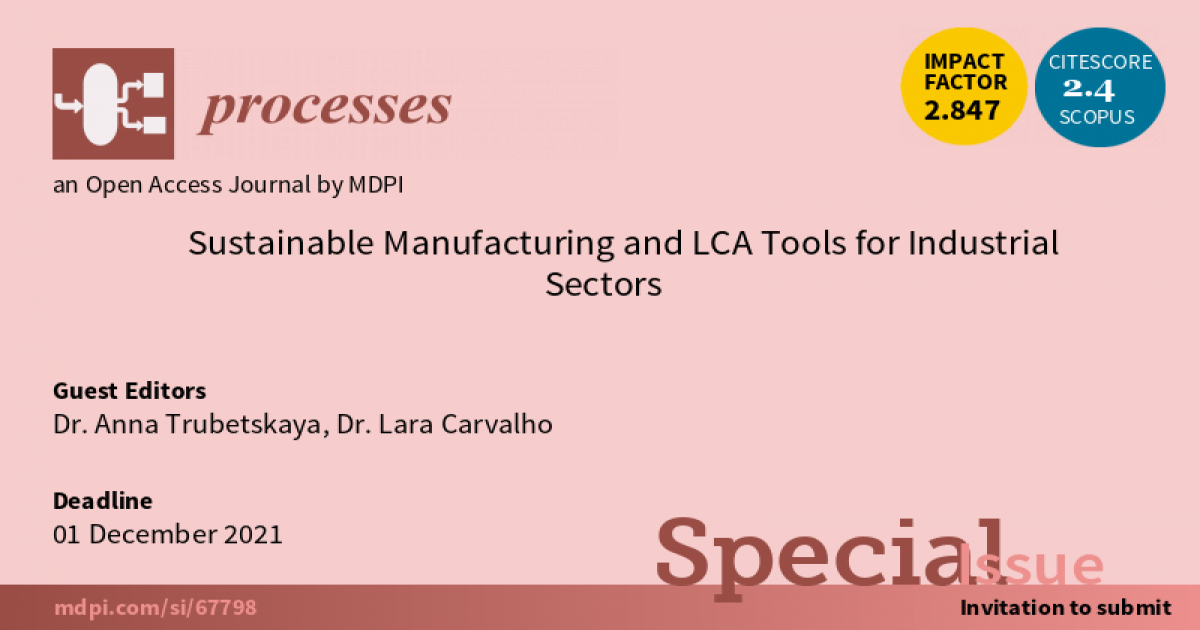Sustainable Manufacturing and LCA Tools for Industrial Sectors
A special issue of Processes (ISSN 2227-9717). This special issue belongs to the section "Manufacturing Processes and Systems".
Deadline for manuscript submissions: closed (1 December 2021) | Viewed by 77690

Special Issue Editors
Interests: life cycle analysis; manufacturing; risk models; bioenergy; water systems
Special Issues, Collections and Topics in MDPI journals
Interests: bioenergy; thermochemical conversion systems; system analysis; resource recovery; techno-economic analysis
Special Issue Information
Dear Colleagues,
Life cycle analysis, manufacturing, and risk assessment are valuable tools for identifying resources, reducing the impact on the environment, and defining and mitigating risks in support of the national policy system. Methodologies such as life cycle assessment and manufacturing are very powerful tools that can be used to address trade-offs between life cycle stages, manufacturing supply chains, and different sustainability pillars. This Special Issue aims to explore the most advanced solutions in life cycle analysis and sustainable manufacturing. The concept of sustainable manufacturing includes processes that are green, lean, and highly efficient with less consumption and contamination. The assessment of anthropogenic impacts on water quality, including societal and economic impacts of associated risks due to solid waste management practices, will be a part of this Special Issue. The scope of this Special Issue will also cover progress in advanced risk assessment, risk management, and decision-making tools. Specific case studies, conceptual frameworks, and integrated risk modeling approaches, including multicriteria decision analysis and life cycle analysis, are welcome. This Special Issue will include both research and state-of-the-art manuscripts on the interactions between technology, consumption, and policy to help identify more sustainable solutions for both production and consumption systems. Sustainable solutions will be identified through investigations in both the public sector and industrial process engineering to make our planet “greener” using appropriate scientific and decision-making tools.
Authors are encouraged to contact one of the editors to discuss the relevance of the selected topic before the submission deadline.
Dr. Anna Trubetskaya
Dr. Lara Carvalho
Guest Editors
Manuscript Submission Information
Manuscripts should be submitted online at www.mdpi.com by registering and logging in to this website. Once you are registered, click here to go to the submission form. Manuscripts can be submitted until the deadline. All submissions that pass pre-check are peer-reviewed. Accepted papers will be published continuously in the journal (as soon as accepted) and will be listed together on the special issue website. Research articles, review articles as well as short communications are invited. For planned papers, a title and short abstract (about 100 words) can be sent to the Editorial Office for announcement on this website.
Submitted manuscripts should not have been published previously, nor be under consideration for publication elsewhere (except conference proceedings papers). All manuscripts are thoroughly refereed through a single-blind peer-review process. A guide for authors and other relevant information for submission of manuscripts is available on the Instructions for Authors page. Processes is an international peer-reviewed open access monthly journal published by MDPI.
Please visit the Instructions for Authors page before submitting a manuscript. The Article Processing Charge (APC) for publication in this open access journal is 2400 CHF (Swiss Francs). Submitted papers should be well formatted and use good English. Authors may use MDPI's English editing service prior to publication or during author revisions.
Keywords
- sustainability
- risk analysis
- water, soil, air
- life cycle analysis
- manufacturing
Benefits of Publishing in a Special Issue
- Ease of navigation: Grouping papers by topic helps scholars navigate broad scope journals more efficiently.
- Greater discoverability: Special Issues support the reach and impact of scientific research. Articles in Special Issues are more discoverable and cited more frequently.
- Expansion of research network: Special Issues facilitate connections among authors, fostering scientific collaborations.
- External promotion: Articles in Special Issues are often promoted through the journal's social media, increasing their visibility.
- e-Book format: Special Issues with more than 10 articles can be published as dedicated e-books, ensuring wide and rapid dissemination.
Further information on MDPI's Special Issue policies can be found here.






